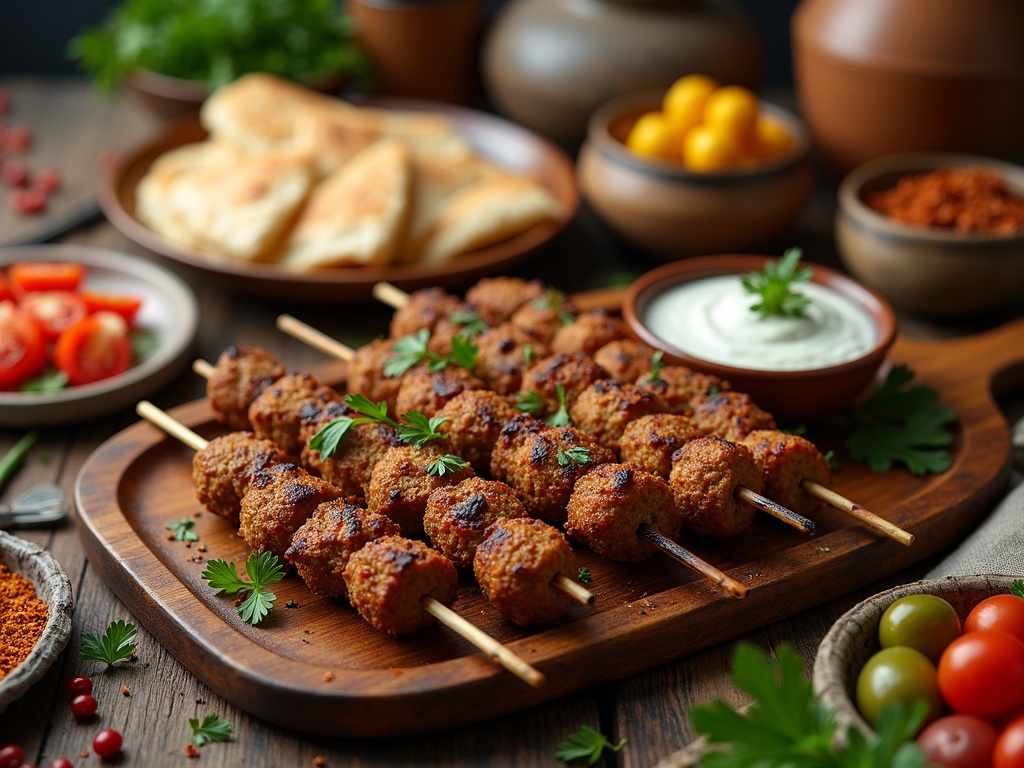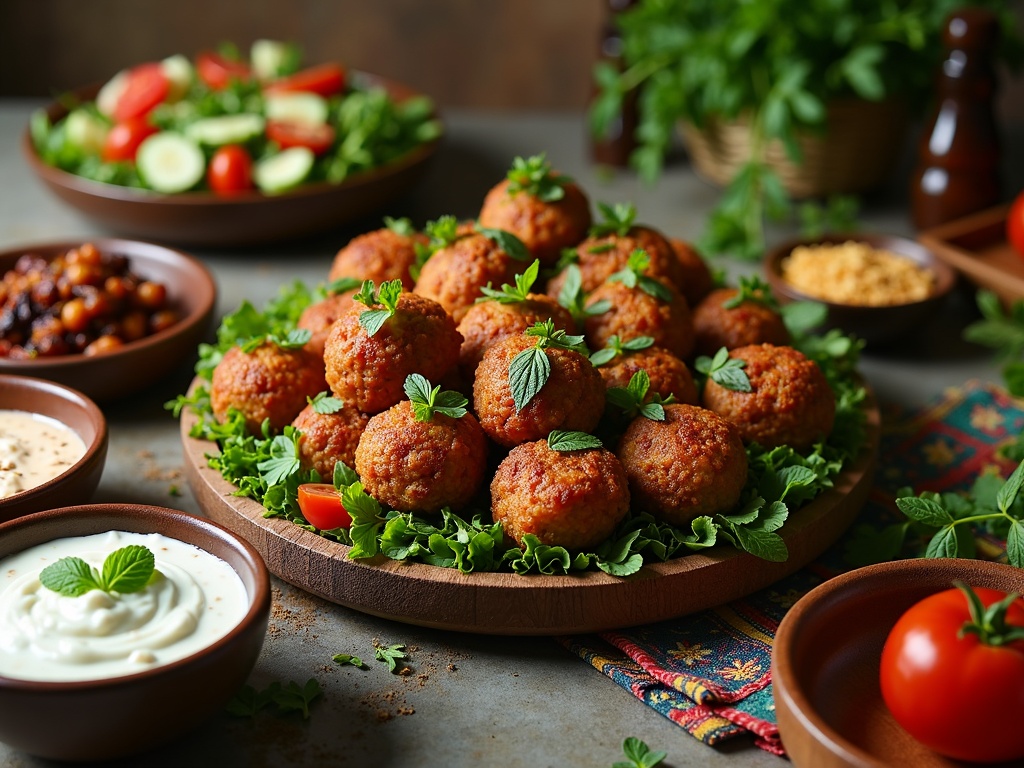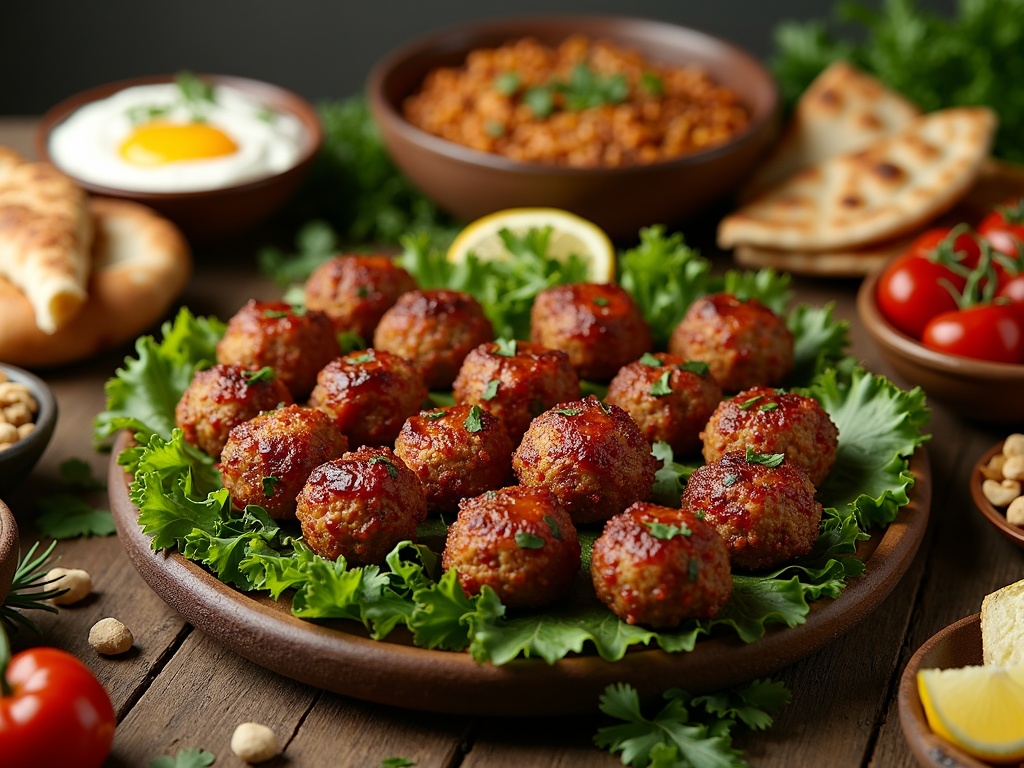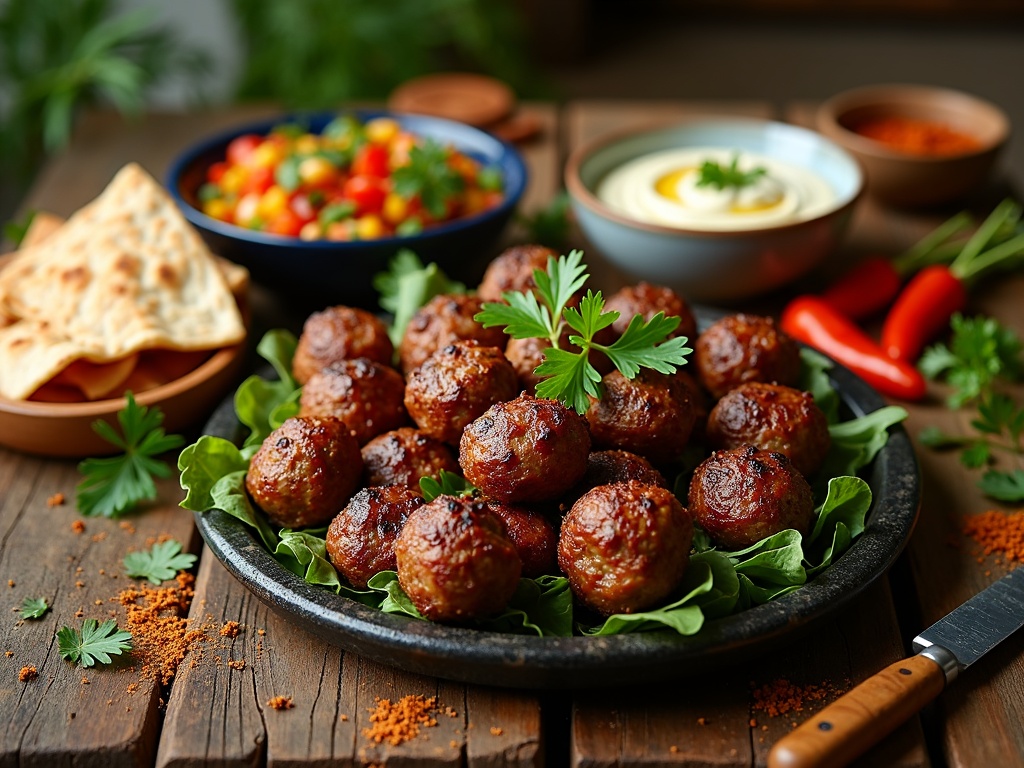Lamb kofta stands as one of the most beloved dishes across Middle Eastern and Mediterranean cuisines, featuring perfectly seasoned ground lamb formed into cylinders or patties, then grilled to juicy perfection. This adaptable dish highlights regional diversity with variations like Turkish köfte served with flatbread and yogurt sauce, Greek keftedes featuring mint, and Egyptian kofta with aromatic spices like cardamom.
Find In This Article
Key Takeaways
- Lamb kofta contains 21-25g of protein per serving while providing essential nutrients like Vitamin B12 (160% daily value) and zinc (40% daily requirement).
- The signature flavor profile comes from a precise blend of garlic, onion, cumin, coriander, fresh parsley, salt, and black pepper.
- Traditional cooking methods include grilling for smoky flavor, baking for healthier results, or pan-frying for a crispy exterior that seals in juices.
- High-quality lamb mince with approximately 20% fat content ensures juicy koftas that remain moist during cooking.
- Beyond street food, lamb kofta serves as a symbol of hospitality in Middle Eastern culture, perfect for both casual gatherings and formal celebrations.
Discover This Ancient Middle Eastern Delicacy
Lamb kofta stands as one of the most cherished dishes across Middle Eastern and Mediterranean cuisines. I’ve found this ancient recipe carries centuries of culinary tradition while remaining incredibly relevant in today’s global food scene. The dish features perfectly seasoned ground lamb formed into cylinders or patties, then grilled to juicy perfection.
A Rich Cultural Heritage
The beauty of lamb kofta lies in its regional diversity. In Turkey, you’ll find köfte served with flatbread and yogurt sauce, while Greek keftedes often include mint and are sometimes served with tzatziki. Egyptian kofta typically features more aromatic spices like cardamom alongside the traditional seasonings. These variations highlight how different cultures have embraced and adapted this traditional lamb dish to suit local tastes.
The global popularity of lamb kofta isn’t surprising when you look at the numbers. The global lamb meat market was valued at $15 billion in 2022 and is growing steadily at a 5% CAGR through 2028. This growth reflects both the increasing interest in international cuisines and the nutritional benefits of lamb as a protein source.
Creating Perfect Kofta at Home
The magic of lamb kofta comes from its masterful blend of aromatics and spices. I’ve found these key ingredients create the signature flavor profile:
- Garlic and onion provide the aromatic base
- Cumin adds warmth and depth
- Coriander contributes citrusy notes
- Fresh parsley brings brightness and color
- Salt and black pepper enhance all other flavors
The meat itself matters tremendously. High-quality lamb mince with the right fat content (around 20%) ensures juicy koftas that won’t dry out during cooking. Many home cooks mix in a small amount of breadcrumbs or soaked bread to improve texture.
The cooking technique is equally important. While traditionally grilled over charcoal for that smoky flavor, koftas can also be pan-fried or baked with excellent results. The key is high heat to develop a flavorful crust while maintaining a tender interior.
Serving options are versatile – wrapped in flatbread with fresh vegetables, alongside rice pilaf, or as part of a larger meat-focused meal. A cooling yogurt sauce provides the perfect counterpoint to the rich, spiced meat.
Far from just a street food, lamb kofta represents one of the most adaptable dishes from Middle Eastern cuisine, equally at home at casual gatherings or formal dinners.

Why Lamb Kofta Is Your New Healthy Protein Choice
Looking for a protein choice that’s not just nutritious but also bursting with flavor? Lamb kofta might be exactly what you need. These seasoned meatballs or patties, common throughout Middle Eastern and South Asian cuisines, pack a powerful nutritional punch while tantalizing your taste buds.
Impressive Nutritional Profile
The nutritional stats of lamb kofta make it stand out as a protein powerhouse. A typical 100g serving contains just 250-300 calories, making it a relatively moderate calorie option for those watching their intake. But don’t let the modest calorie count fool you – these savory treats deliver an impressive 21-25g of protein per serving, helping you meet your daily protein goals with just one portion.
I’ve found that incorporating lamb mince recipes like kofta into my meal plan provides substantial nutrition without the heaviness of some other protein sources. The fat content sits around 20g per serving, which might seem high at first glance, but it’s important to note that lamb contains healthy fats including omega-3 fatty acids. Additionally, the carbohydrate content is minimal, making lamb kofta an excellent choice for those following low-carb eating plans.
Beyond macronutrients, lamb kofta shines in its micronutrient content. It’s exceptionally rich in Vitamin B12, providing about 160% of your daily value in just one serving. This essential vitamin plays a crucial role in:
- Red blood cell formation
- Neurological function
- DNA synthesis
- Energy production
Zinc is another standout nutrient in lamb kofta, with a single serving providing approximately 40% of your daily requirement. This mineral is vital for:
- Supporting immune system function
- Promoting wound healing
- Maintaining metabolism
- Supporting cell growth and division
The rich lamb flavor combined with traditional spices like cumin, coriander, and mint doesn’t just make kofta delicious – it also adds additional health benefits through these antioxidant-rich herbs and spices.
For those concerned about red meat consumption, it’s worth noting that lamb is often grass-fed, which generally results in a healthier fatty acid profile compared to conventional grain-fed beef. The traditional preparation of kofta also typically includes onions, garlic, and fresh herbs, all of which contribute additional nutrients and health-promoting compounds.
I’ve discovered that lamb kofta works wonderfully as part of a balanced meal when paired with fresh vegetables, whole grains, or legumes. Try serving it with a crisp salad, wrapped in whole grain flatbread with yogurt sauce, or alongside roasted vegetables for a complete and satisfying meal.
For those exploring different cultural cuisines, gosht dishes and lamb kofta share similar flavor profiles while offering diverse textures and preparations. This versatility makes lamb an excellent protein to experiment with in your kitchen.
When preparing lamb kofta at home, you can control the fat content by selecting leaner cuts of lamb and adding moisture through ingredients like grated onion or yogurt rather than additional fat. This allows you to customize the nutritional profile to better suit your specific dietary needs while still enjoying this flavorful dish.
With its impressive protein content, essential vitamins and minerals, and adaptability to various cuisines and dietary preferences, lamb kofta deserves a spot in your meal rotation as a healthy, satisfying protein choice.

Master These Cooking Techniques
Cooking lamb kofta with minced meat lets you experiment with different techniques, each bringing unique flavors and textures to this classic dish. I’ve perfected these methods through years of practice, and I’m excited to share my insights with you.
Finding Your Perfect Cooking Method
Traditional grilling is my go-to method when I want that authentic, smoky flavor that makes kofta truly special. I thread the seasoned meat onto metal skewers and place them over medium-high heat, turning occasionally. The open flame caramelizes the exterior while the fat drips away, creating that distinctive char mark pattern that’s both visually appealing and flavorful. For best results, I make sure my grill is properly preheated and keep a close eye to prevent burning.
Baking offers a healthier alternative that’s perfect for busy weeknights. I place my shaped kofta on a lined baking sheet and cook at 375°F for about 20 minutes. This hands-off approach produces tender, juicy results with minimal added fat. To enhance browning, I brush the kofta with a little olive oil before baking and turn them halfway through cooking time.
For a crispy exterior that locks in juices, pan-frying delivers outstanding results. I heat a tablespoon of oil in a skillet over medium heat and cook the lamb kofta like traditional gosht recipes, about 3-4 minutes per side until golden brown. This method creates a delicious crust while keeping the inside moist and tender.
Each technique creates a distinct eating experience:
- Grilling: Smoky, slightly charred exterior with a juicy center
- Baking: Evenly cooked, tender results with less fat
- Frying: Crispy exterior with a rich, indulgent texture
For an extra special meal, I sometimes combine methods – partially grilling for smoke flavor, then finishing in the oven for perfect doneness. This hybrid approach works particularly well when serving roast lamb alongside kofta for a complete feast.
The secret to perfect kofta lies in maintaining moisture while achieving the right exterior texture. I always let the shaped meat rest in the refrigerator for at least 30 minutes before cooking, which helps the flavors meld and the mixture firm up, preventing it from falling apart during cooking.
From Street Food to Celebration Centerpiece
Lamb kofta has traveled an impressive journey from humble street food carts to becoming the star of celebratory feasts. I’ve witnessed how this versatile dish brings people together across the Middle East and beyond, creating moments of joy around the dinner table.
Symbol of Hospitality and Gathering
In Middle Eastern culture, serving succulent lamb dishes like kofta isn’t just about feeding guests—it’s a profound symbol of hospitality and abundance. When hosts present a platter of perfectly grilled kofta, they’re offering more than food; they’re extending their warmest welcome. The aromatic spiced meat becomes a centerpiece that signals to guests they’re valued and cherished.
The beauty of kofta lies in its ability to foster communal dining. The shared plates encourage conversation and connection as everyone reaches for these flavorful meat skewers. I’ve seen quiet dinner tables transform into lively gatherings once the kofta arrives, with stories and laughter flowing as freely as the food.
Regional Celebrations and Variations
Different regions celebrate kofta in unique ways. The Turkish “kebap” variation features a distinctive spice blend that might include sumac, Aleppo pepper, and sometimes cinnamon, creating a more complex flavor profile than its regional cousins. In Lebanon, celebrations often feature kofta alongside a spread of mezze, creating a feast that can stretch for hours.
For festive occasions, kofta is traditionally paired with:
- Fresh tabbouleh salad with its bright lemon and parsley notes
- Creamy hummus drizzled with olive oil
- Warm, pillowy pita bread
- Tangy yogurt sauce with cucumber and mint
- Grilled vegetables brushed with olive oil
This classic combination creates a balanced meal that satisfies all the senses and has stood the test of time across generations. The tender meat contrasts beautifully with the crunch of fresh vegetables and the softness of the bread.
I’ve found that seasoned minced lamb in kofta offers the perfect canvas for both traditional family recipes and modern interpretations. Whether served at weddings, religious celebrations, or simply when family gathers, kofta transforms ordinary moments into memorable occasions, connecting people to their cultural heritage through food that speaks to the heart.
Create Your Perfect Version
I’ve discovered that lamb kofta is incredibly versatile, allowing for numerous delicious variations to suit your taste preferences. The beauty of this dish lies in its adaptability while maintaining its signature rich flavors and satisfying texture.
Exciting Flavor Combinations
Spiced Lamb Kofta with mint and cinnamon creates a beautiful harmony of warmth and freshness. The cooling mint perfectly balances the aromatic cinnamon, creating depth without overwhelming the natural lamb flavor. For something truly addictive, try incorporating breadcrumbs into your lamb kofta meatballs – they retain moisture and create a lighter texture that’s perfect for serving with flatbread or as party appetizers.
If you’re looking for something with a tangy twist, Persian-style kofta with pomegranate molasses adds a wonderful sweet-sour dimension that cuts through the richness of quality lamb. The molasses creates a beautiful glaze when grilled, adding both visual appeal and flavor complexity.
Not a meat eater? A vegetarian option using lentils captures the essence of traditional kofta with its hearty texture and ability to absorb spices beautifully. I find red lentils work particularly well when combined with mushrooms for an umami boost.
For those watching their fat intake, a lighter version using ground chicken provides a leaner alternative without sacrificing flavor. The key is adding enough aromatics and moisture to prevent dryness – grated onion and a touch of olive oil work wonders here.
Regional variations often incorporate different minced meat combinations to achieve the perfect texture. Some traditions call for adding small pieces of lamb fat or beef suet to leaner lamb meat, ensuring juicy, tender kofta even after grilling.
What makes kofta special is its ability to transform simple ingredients into something extraordinary. Each variation brings its own character while honoring the dish’s origins. I recommend experimenting with different combinations until you find your perfect version – the one that brings your family running to the table with anticipation.

Sources:
Food Industry Review 2022, Journal of Nutrition and Health 2021, Culinary Traditions 2023, Food and Culture Studies 2022

